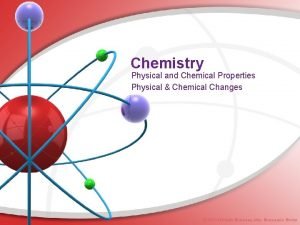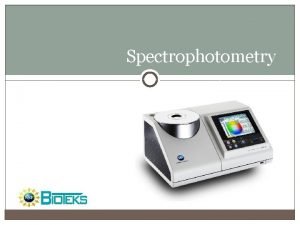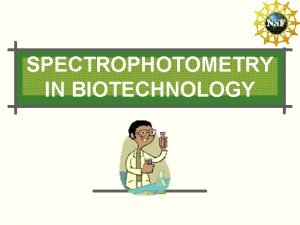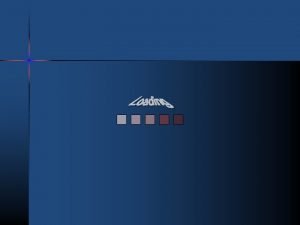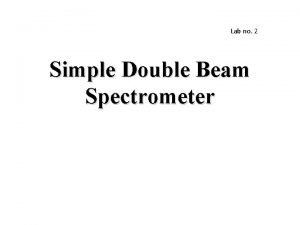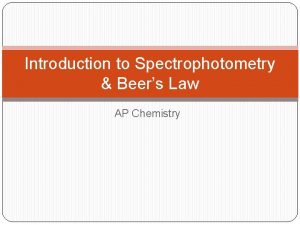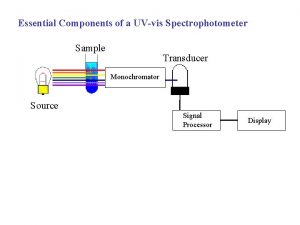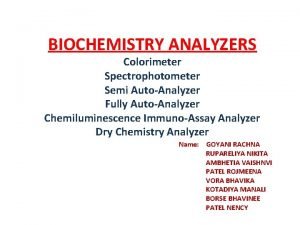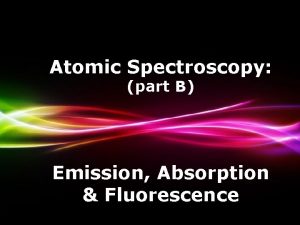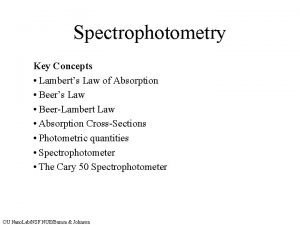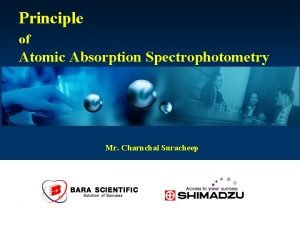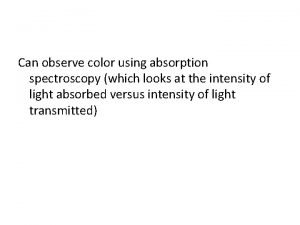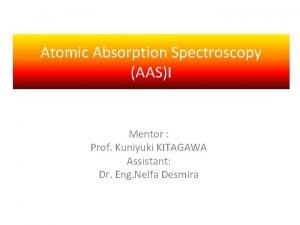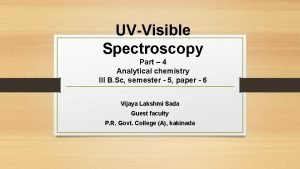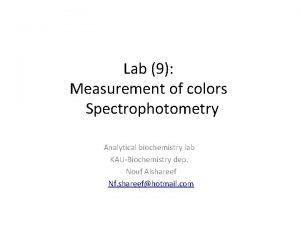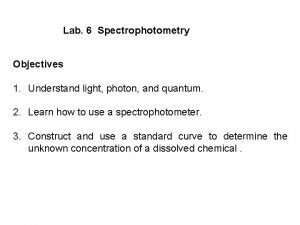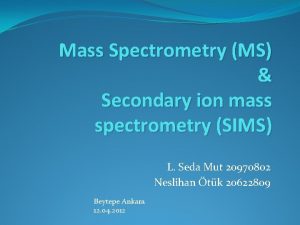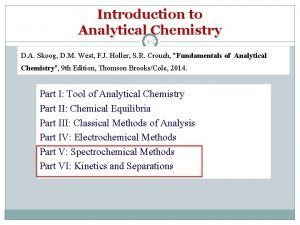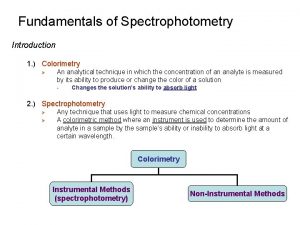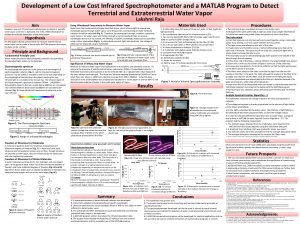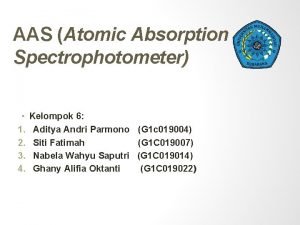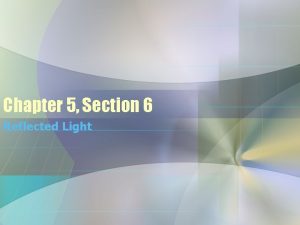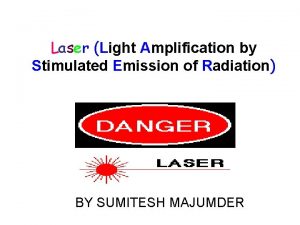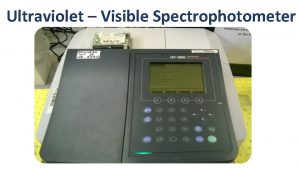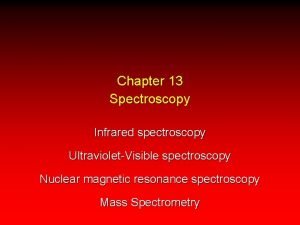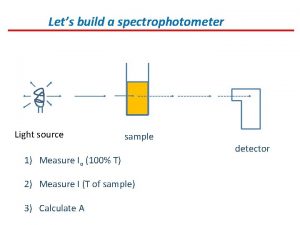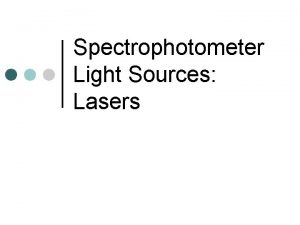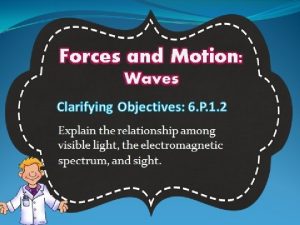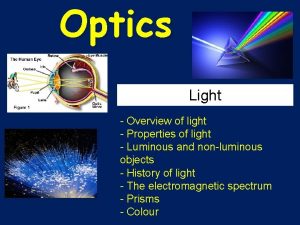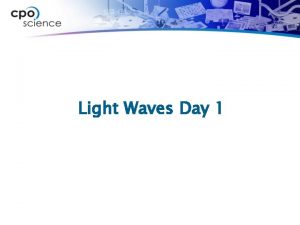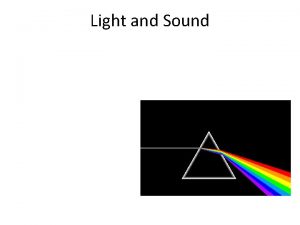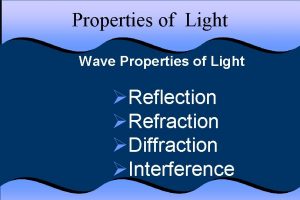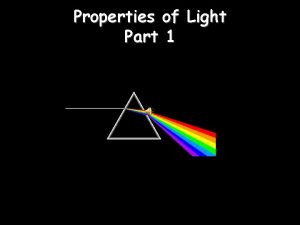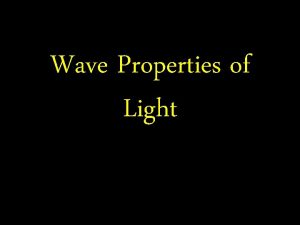chapter 2 Quantitative Spectroscopy Light Properties Spectrophotometer Model





















 Absorbance Transmittance(%) ε(L/mole-cm) L(cm) 30 2000 1. 00 3. Complete the following table. [X](M) Absorbance Transmittance(%) ε(L/mole-cm) L(cm) 30 2000 1. 00](https://slidetodoc.com/presentation_image/2a48a965404c03efb838916f306fd8c5/image-22.jpg)









- Slides: 31

chapter 2 Quantitative

Spectroscopy – Light Properties

Spectrophotometer Model of light interaction with matrix and how spectrophotometer works

Spectroscopy – Quantification Terms Transmittance (T) – the fraction of incident radiation transmitted by the medium: T = I/I 0 Absorbance (A) – the amount of incident radiation absorb by the medium and expressed by: � A = log(1/T) = - log. T = log P 0/P

BEER LAMBERT LAW As the cell thickness increases, the intensity of I (transmitted intensity of light ) decreases.

T= T- Transmittance I I 0 - Original light intensity I- Transmitted light intensity I % Transmittance = 100 x I 0 T= %T 100 Absorbance (A) = Log 100 %T A = 2 – Log %T %T= antilog (2 – A )

Spectroscopy - Quantification � Beer’s Law (Beer – Bourguer – Lambert Law) � Radiation energy decays exponentially T = P/P 0 = 10 -kb Where: � k – constant � T – the transmittance – the fraction of � transmitted radiant energy � b – the pathlength of the medium

A CL = KCL by definition and it is called the Beer Lambert Law. A = KCL K = Specific Extinction Coefficient ---- 1 g of solute per liter of solution A = ECL E = Molar Extinction Coefficient ---Extinction Coefficient of a solution containing 1 g molecule of solute per 1 liter of solution

Beer Law Chart

E differs from K (Specific extinction Coefficient) by a factor of molecular weight. UNITS A = ECL A = No unit (numerical number only)

L = Cm C = Moles/Liter A = KCL A = No unit K= Liter Cm Gram C = Gram/Liter L = Cm

STEPS IN DEVELOPING A SPECTROPHOTOMETRIC ANALYTICAL METHOD 1. Run the sample for spectrum 2. Obtain a monochromatic wavelength for the maximum absorption wavelength. 3. Calculate the concentration of your sample using Beer Lambert Equation: A = KCL

SPECTROPHOTOMETR READINGS

ULTRAVIOLET SPECTRUM

There is some A vs. C where graph is linear. NEVER extrapolate beyond point known where becomes non-linear.

SPECTROMETRIC ANALYSIS USING STANDARD CURVE Avoid very high or low absorbencies when drawing a standard curve. The best results are obtained with 0. 1 < A < 1. Plot the Absorbance vs. Concentration to get a straight line

CELLS UV Spectrophotometer Quartz (crystalline silica) Visible Spectrophotometer Glass IR Spectrophotometer Na. Cl

LIGHT SOURCES UV Spectrophotometer 1. Hydrogen Gas Lamp 2. Mercury Lamp Visible Spectrophotometer 1. Tungsten Lamp IR Spectrophotometer 1. Carborundum (SIC)

UV SPECTROMETER APPLICATION Protein Amino Acids (aromatic) Pantothenic Acid Glucose Determination Enzyme Activity (Hexokinase)

VISIBLE SPECTROPHOTOMETER APPLICATION Niacin Pyridoxine Vitamin B 12 Metal Determination (Fe) Fat-quality Determination (TBA) Enzyme Activity (glucose oxidase)

EXAMPLES 1. Calculate the Molar Extinction Coefficient ε at 351 nm for aquocobalamin in 0. 1 M phosphate buffer. p. H = 7. 0 from the following data which were obtained in 1 Cm cell. Solution. C x 105 M 2. 3. Io I A 2. 23 100 27 B 1. 90 100 32 The molar extinction coefficient (ε) of compound riboflavin is 3 x 103 Liter/Cm x Mole. If the absorbance reading (A) at 350 nm is 0. 9 using a cell of 1 Cm, what is the concentration of compound riboflavin in sample? The concentration of compound Y was 2 x 10 -4 moles/liter and the absorption of the solution at nm using 1 Cm quartz cell was 0. 4. What is molar extinction coefficient of compound Y? 300 the
 Absorbance Transmittance(%) ε(L/mole-cm) L(cm) 30 2000 1. 00](https://slidetodoc.com/presentation_image/2a48a965404c03efb838916f306fd8c5/image-22.jpg)
3. Complete the following table. [X](M) Absorbance Transmittance(%) ε(L/mole-cm) L(cm) 30 2000 1. 00 0. 5 2500 1. 00 2. 5 x 10 -3 0. 2 1. 00 4. 0 x 10 -5 5000 2. 0 x 10 -4 150 [X](M) = Concentration in Mole/L 4. The molar absorptivity of a pigment (molecular weight 300) is 30, 000 at 550 nm. What is the absorptivity in L/g-cm. ! 5. The iron complex of o-phenanthroline (Molecular weight 236) has molar absorptivity of 10, 000 at 525 nm. If the absorbance of 0. 01 is the lowest detectable signal, what concentration in part per million can be detected in a 1 -cm cell?

A = 0. 01 ε= 10000 L / mole x cm L = 1 cm A = ECL 0. 01= 10000 L/mole X Cm X C (Concentration) x 1 Cm C = mole / Liter C = X mole / Liter = X mole (236 g/mole) / Liter (1000 Cm 3) x PPM (10 -6 g/Cm 3) = X mole (236 g / mole) / Liter x 1 Liter / 1000 Cm 3 x ( PPM) 10 -6 g / Cm 3) =x PPM = 1 ug / Cm 3 1 ug = 10 -6 g

Spectroscopy –Multimolecules Effect

Spectroscopy -Mixture � Multi-component mixture: � AT = A 1 + A 2 +A 3 + An � AT = ε 1 bc 1 + ε 2 bc 2 + ε 3 bc 3 + εnbcn Where: 1, 2, 3, …. , n – refer to absorbing components

EXAMPLES Potassium dichromate and potassium permanganate in 1 M H 2 SO 4 has absorbance spectra overlap (overlab). K 2 Cr 2 O 7 have maximum absorbance at 440 nm and KMn. O 4 545 nm. Mixture of both substances have been analyzed by measuring the absorbance of solution at the second wavelength with the following results: A 440 = 0. 405, A 545 = 0. 712. 1. 0 cm cell used. Absorbance K 2 Cr 2 O 7 pure solution (1 x 10 -3 M) and KMn. O 4 (2 x 10 -4 M) in 1 M H 2 SO 4 by using the same cell are as follows: A Cr, = 0. 374 440, A Cr, 545 th = 0. 009, A Mn, 440 = 0. 019, A Mn, 545 = 0. 475 Calculate the concentration of dichromate and permanganate in the sample solution?

Spectroscopy – Beer’s Law Limitations Deviations from the direct �proportionality (b=const) �Instrumental Deviations �Chemical Deviations

Beer’s Law Limitations Deviations from the direct proportionality (b = const) � Valid at concentration usually below 0. 01 M � Molecules interference – distance between molecules affects charge distribution of molecules (ions) � Effect of refractive index –concentration affects refractive index ε is affected (low, less important)

Spectroscopy - Deviations

Beer’s Law Limitations Chemical Deviations Association, dissociation and reaction with solvent and other molecules

Beer’s Law Limitations Instrumental Deviations � monochromatic radiation – quality of monochromator and control of bandwidth and slit � Instrumental noise – accuracy of measurement of transmittance – quality of detector
 Light light light chapter 23
Light light light chapter 23 Into the light chapter 22
Into the light chapter 22 Light light light chapter 22
Light light light chapter 22 Qualitative and quantitative physical properties
Qualitative and quantitative physical properties Lambert's law
Lambert's law Spectrophotometry in chemistry
Spectrophotometry in chemistry Blank for spectrophotometer
Blank for spectrophotometer Dr 2800
Dr 2800 Disadvantages of double beam spectrophotometer
Disadvantages of double beam spectrophotometer Introduction to spectrophotometry
Introduction to spectrophotometry Spectrophotometer parts
Spectrophotometer parts Semi auto analyzer principle
Semi auto analyzer principle Atomic fluorescence spectroscopy ppt
Atomic fluorescence spectroscopy ppt Beer's law chemistry
Beer's law chemistry Principle of absorption
Principle of absorption Color wheel absorbance
Color wheel absorbance Beer lambert law
Beer lambert law Single vs double beam spectrophotometer
Single vs double beam spectrophotometer What is complementary color
What is complementary color Objective of spectrophotometer
Objective of spectrophotometer Principle of mass spectroscopy
Principle of mass spectroscopy How to use spectrophotometer
How to use spectrophotometer Spectrophotometry
Spectrophotometry Low cost spectrophotometer
Low cost spectrophotometer Komponen aas
Komponen aas Intensive vs extensive
Intensive vs extensive Physical properties of ice cube
Physical properties of ice cube Properties of light
Properties of light What are the 7 properties of light
What are the 7 properties of light 5 properties of light
5 properties of light Properties of laser light
Properties of laser light Stimulated emission
Stimulated emission



